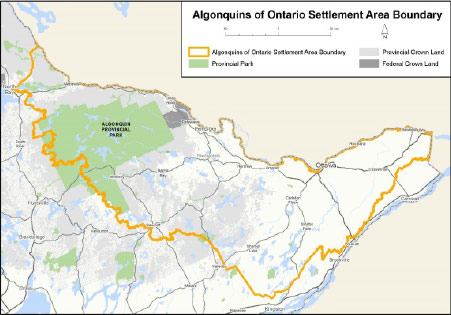Overview of Treaty Negotiations
Algonquin petitions to the Crown seeking recognition
and protection for Algonquin land and other rights date back to 1772.
In 1983, the Algonquins of Pikwàkanagàn First Nation (known at the time as the Algonquins of Golden Lake) commenced the land claim by formally submitting the most recent petition, with supporting research, to the Government of Canada in 1983 and the Government of Ontario in 1985. The Province of Ontario accepted the claim for negotiations in 1991 and the Government of Canada joined the negotiations in 1992.
Algonquins of Ontario Settlement Area Boundary
 To view Algonquin Traditional Territory in Ontario, click here.
To view Algonquin Traditional Territory in Ontario, click here.
The Algonquins of Ontario claim includes an area of 9 million acres within the watersheds of the Kichisippi (Ottawa River) and the Mattawa River in Ontario, an unceded territory that covers most of eastern Ontario. More than 1.2 million people live and work within the Settlement Area. There are 84 municipal jurisdictions fully and partially located within the Settlement Area, including 75 lower and single tier municipalities and 9 upper tier counties.
The Algonquins of Ontario (AOO) and the Governments of Canada and Ontario are working together to resolve this land claim through a negotiated settlement. If successful, the agreement we reach will take the form of a modern-day treaty with aboriginal and treaty rights protected under Section 35 of the Constitution Act, 1982.
The Algonquin Treaty will provide certainty about the ownership, use and management of land and natural resources for the Algonquins and everyone else in the Settlement Area. This will remove the barriers to economic growth created by existing uncertainties and contribute to a more stable social, political and economic environment with greater potential for regional economic development, jobs and growth.
Algonquin Objectives in our Negotiations
- Reaffirm the honour and pride of the Algonquin people
- Ensure the survival and prosperity of the Algonquin people and culture
- Raise awareness and understanding about Algonquin history and culture
- Achieve reconciliation of the relationships of the Algonquins with the Governments of Ontario and Canada
The Algonquin Negotiation Process
The Algonquin negotiations are following a process that, if successful, will result in a Final Agreement or Algonquin Treaty. The general steps in this process include:
1. Key Historic Elements of the Land Claim
The Province of Ontario accepted the claim for negotiations in 1991 and the Government of Canada joined the negotiations in 1992. Guiding principles, agreed to by the AOO, Ontario and Canada, were set out in a Statement of Shared Objectives originally signed in 1994 and re-affirmed by the three negotiating Parties in March 2006.
2. Voter Enrolment
An Addendum protocol was created, establishing initial criteria for Electors, with the first election of ANRs in 2005. Following the election of the ANRs, ongoing efforts were made to further refine elector enrolment/criteria for voters. A Preliminary Voters List was posted in March 2011 and the enrolment process was reinstated in 2012. A Preliminary Voters List (Updated) was posted in May 2012.
3. Negotiation of an Agreement-in-Principle
An AIP is the first step towards reaching a modern treaty. The AIP will not be a legally binding document. It will set out the basic elements of a proposed settlement. This will provide a framework for the negotiation of a Final Agreement that will clarify and define the rights of the AOO as they relate to land and natural resources, among other matters, and the obligations of all three Parties.
4. AIP Ratification
The proposed AIP will be put to a Ratification Vote by the Algonquin Voters as soon as possible.
5. Evaluation of AIP Ratification Vote
If the AIP is approved by a sufficient number of Algonquin Voters within each community, then the Governments of Ontario and Canada will be asked to approve it. Following these approvals the Parties will engage in negotiations towards a Final Agreement. If the AIP is not ratified, the Parties will have to consider the reasons for the failure and the negotiations may or may not resume.
6. Treaty Negotiation and Ratification
A Final Agreement will set out the rights of the AOO. It will have to be ratified through another vote by the AOO. The Governments of Ontario and Canada will then each have to adopt settlement legislation to give the force of law to a modern day Algonquin Treaty protected under the Canadian Constitution.
7. Implementation
An implementation plan will be developed and agreed to by the Parties as part of the settlement negotiations, prior to the Final Agreement. It will outline the Parties’ responsibilities to implement the terms of the Final Agreement. Settlement funds will be deposited in Trusts within the first two years following the Final Agreement. Lands will then be transferred over several years following the Final Agreement.
8. Enrolment of Beneficiaries
Once ratified and given the force of law, the Algonquin Treaty will require individual Algonquins to enrol if they wish to become Beneficiaries.

